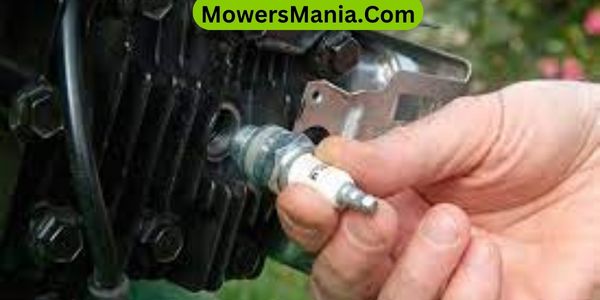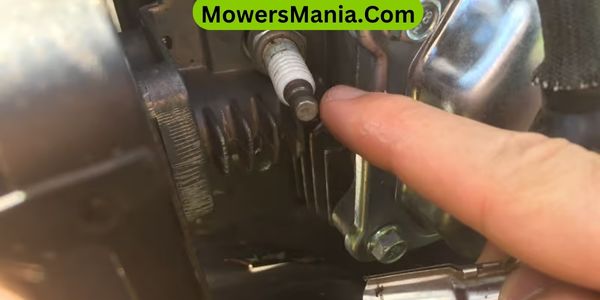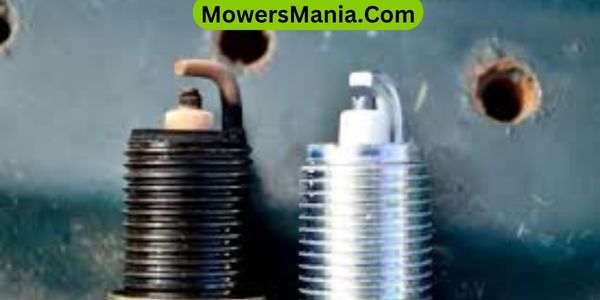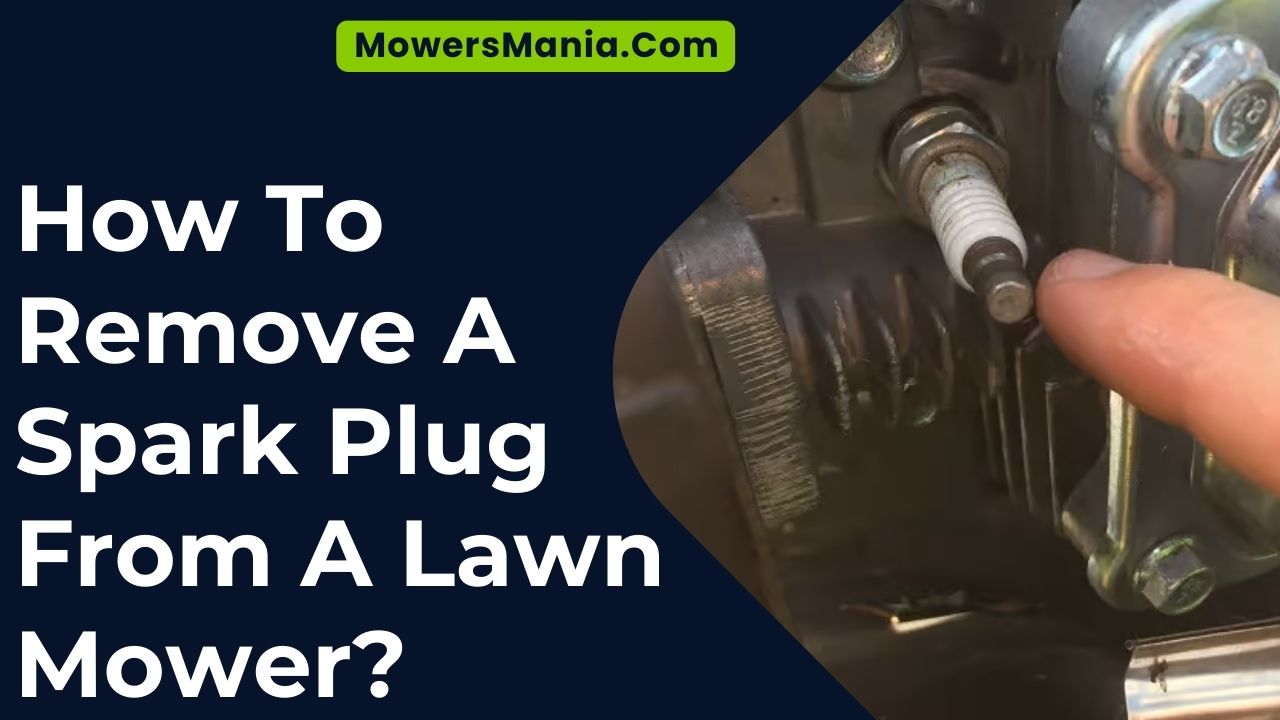When it’s time to give your lawn mower some TLC, one important task is removing the spark plug.
It’s a bit like pulling a tiny sword from its sheath.
With the right technique and tools, it’s a straightforward job that can help keep your mower running smoothly.

Let’s walk through the steps to safely and effectively remove the spark plug from your lawn mower.
Importance of Spark Plug Maintenance
You should understand that regular maintenance of your spark plug is crucial for the proper functioning of your lawn mower.
The spark plug plays a vital role in the ignition process, igniting the air-fuel mixture in the engine’s combustion chamber. Over time, carbon deposits and wear and tear can cause the spark plug to deteriorate, leading to issues such as hard starting, rough idling, and poor fuel economy.
By regularly inspecting and cleaning or replacing your spark plug, you can ensure that your lawn mower continues to operate efficiently.
Neglecting spark plug maintenance can result in more serious problems, such as engine misfires and potential damage to other engine components.
In severe cases, a worn-out spark plug can lead to permanent engine damage, requiring costly repairs or even replacement of the entire mower.
To avoid these issues, it’s recommended to follow the manufacturer’s guidelines for spark plug maintenance, including regular inspection, cleaning, and replacement at specified intervals.
By doing so, you can maintain the performance and longevity of your lawn mower, ensuring that it remains a reliable tool for keeping your lawn in top condition.
Necessary Tools for Removal
When removing a spark plug from a lawn mower, it’s important to have the necessary tools, such as a spark plug socket and a ratchet.
These tools will help you safely and effectively remove the spark plug without causing any damage to the mower.
Here are the necessary tools for removing a spark plug from a lawn mower:
- Spark Plug Socket: This specialized socket is designed to fit over the spark plug, allowing you to loosen and remove it without causing any damage.
- Ratchet: A ratchet provides the necessary leverage to turn the spark plug socket and loosen the spark plug from its position in the mower’s engine.
- Extension Bar: An extension bar can be attached to the ratchet to reach spark plugs that are recessed or difficult to access within the mower’s engine.
- Socket Wrench: This tool is essential for turning the ratchet and loosening the spark plug from its threaded position.
- Gap Gauge: After removing the spark plug, a gapping tool can be used to ensure the new spark plug has the correct gap for optimal performance.
Having these tools on hand will make the process of removing a spark plug from your lawn mower much easier and ensure that you can perform the task safely and effectively.
Locating the Spark Plug

First, locate the spark plug on the lawn mower engine. It’s typically found near the base of the engine and has a thick wire connected to it.
You’ll need a spark plug socket and ratchet to remove it.
Identifying Plug Location
To locate the spark plug on your lawn mower, start by referring to the operator’s manual for the specific location within the engine.
If you don’t have the manual, follow these steps to identify the plug’s location:
- Inspect the Engine Cover: Look for a cover on top of the engine; the spark plug may be positioned under or near it.
- Follow the Wire: Trace the thick, rubber-coated wire from the ignition coil, as it usually leads directly to the spark plug.
- Check Near the Cylinder: The spark plug is typically located near the cylinder, often protruding from the engine block.
- Look for a Hexagonal Nut: The spark plug will have a hexagonal nut on top, which is used for removal and installation.
- Refer to Manufacturer’s Guidelines: If you’re still unsure, consult the manufacturer’s guidelines for your specific mower model.
Tools Needed for Removal
You will need a socket wrench with the appropriate size socket to remove the spark plug from your lawn mower. It’s important to use the right tools to avoid damaging the spark plug or the mower’s engine.
Here’s a table to help you locate the spark plug and identify the tools needed for its removal:
| Spark Plug Location | Required Tools |
|---|---|
| Under the engine cover near the base of the mower | Socket wrench with spark plug socket |
| Attached to a rubber or metal boot | Extension for the socket wrench |
| Positioned at the side of the engine | Ratchet handle for the socket wrench |
Using these tools, you can effectively remove the spark plug from your lawn mower without causing any damage.
Removing the Spark Plug Wire
When removing the spark plug wire, ensure you do so carefully to avoid any potential electrical shocks.
It’s important to use insulated pliers to grip the wire and pull it off the spark plug.
Safety should always be your top priority when handling any electrical components of the lawn mower.
Safety First: Remove Carefully
Before removing the spark plug wire from your lawn mower, ensure that the engine is completely cool to prevent any accidental burns.
Here are some essential safety tips to keep in mind:
- Wear protective gloves to shield your hands from any potential dirt or debris.
- Use insulated pliers to gently grip the spark plug wire and carefully pull it off the spark plug.
- Avoid pulling the wire itself as this may damage the ignition system.
- Keep the wire away from the spark plug to prevent accidental ignition while working on the mower.
- Inspect the wire for any damage such as cracks or fraying, and replace it if necessary to ensure proper functioning of the mower.
Use Insulated Pliers
To safely remove the spark plug wire from your lawn mower, follow these steps:
- Begin by locating the spark plug wire, which is typically connected to the top of the spark plug.
- Use insulated pliers to firmly grip the boot of the wire. Ensure that the pliers are fully insulated to avoid any risk of electric shock.
- With a steady hand, gently rock the insulated pliers back and forth while pulling the wire away from the spark plug. It’s important to use a straight, consistent motion to avoid damaging the wire or the spark plug.
- Once the wire is disconnected from the spark plug, set it aside in a safe place.
Remember to always exercise caution when working with electrical components to prevent any accidents.
Using the Proper Technique
To properly remove a spark plug from your lawn mower, first, ensure that you have the correct spark plug socket and extension. Using the proper technique is crucial to avoid damaging the spark plug or the mower engine.
Here’s how to do it:
- Prepare the mower: Turn off the mower and allow it to cool down before attempting to remove the spark plug. This will prevent any accidents and ensure your safety.
- Locate the spark plug: Identify the location of the spark plug on your lawn mower. It’s usually situated near the engine and has a rubber boot covering the top of the plug.
- Use the spark plug socket: Attach the spark plug socket to the extension and then carefully place it over the spark plug. Make sure it fits securely before attempting to loosen the spark plug.
- Remove the spark plug: Gently turn the spark plug counterclockwise to loosen it from the engine. Once it’s loose, carefully remove it from the mower, making sure not to damage the threads.
- Inspect the spark plug: After removal, inspect the spark plug for any signs of damage or wear. This will help you determine if it needs cleaning or replacement.
Inspecting the Spark Plug

First, carefully examine the removed spark plug for any signs of fouling, corrosion, or electrode wear.
Fouling appears as black, oily deposits on the spark plug’s electrodes, indicating potential issues with the fuel system or oil entering the combustion chamber.
Corrosion, often seen as a white, chalky substance on the spark plug’s metal parts, can hinder the plug’s performance.
Additionally, electrode wear, visible as a rounded or pitted appearance, suggests that the spark plug may not be igniting the fuel-air mixture effectively.
Next, check the spark plug gap using a feeler gauge to ensure it falls within the manufacturer’s specifications.
An incorrect gap can lead to misfiring and poor engine performance. If the gap isn’t within the recommended range, carefully adjust it using a gap tool.
Inspect the insulator for cracks or damage, as these can lead to misfires and poor engine operation. Furthermore, examine the threads for any signs of damage, as this can affect the spark plug’s ability to create a proper seal within the engine.
Frequently Asked Questions [FAQs]
Can I Use the Same Technique to Remove a Spark Plug From Any Type of Lawn Mower, or Are There Specific Differences for Different Models?
You can generally use the same technique to remove a spark plug from various lawn mowers, but it’s important to refer to the specific model’s manual for any unique instructions or precautions.
What Should I Do if the Spark Plug Is Difficult to Reach or Seems Stuck in Place?
If the spark plug is difficult to reach or seems stuck in place, try using a spark plug socket and a ratchet. Apply steady pressure and turn the wrench counterclockwise to loosen the plug. Be patient and avoid forcing it.
Are There Any Specific Safety Precautions I Should Take Before Attempting to Remove the Spark Plug?
Before attempting to remove the spark plug, make sure the mower is turned off and the engine has cooled down. Wear protective gloves and eyewear. Always disconnect the spark plug wire to prevent accidental starts.
How Often Should I Be Checking and Replacing the Spark Plug in My Lawn Mower?
You should check and replace the spark plug in your mower annually. Regular maintenance ensures proper functioning and efficiency. To avoid potential issues, inspect it for wear and tear, and swap it out to keep your mower running smoothly.
What Are the Signs That Indicate a Spark Plug Needs to Be Replaced, and How Can I Diagnose These Issues?
If you notice your lawn mower is hard to start, misfires, or has poor fuel efficiency, it may indicate a worn-out spark plug. To diagnose, inspect the plug for fouling or damage. Replace if necessary.
Conclusion
So, now you know the importance of spark plug maintenance and how to remove a spark plug from a lawn mower.
With the right tools and technique, you can easily inspect and replace the spark plug to keep your lawn mower running smoothly.
Regular maintenance will ensure that your lawn mower stays in top working condition, saving you time and money in the long run.
Happy mowing!



